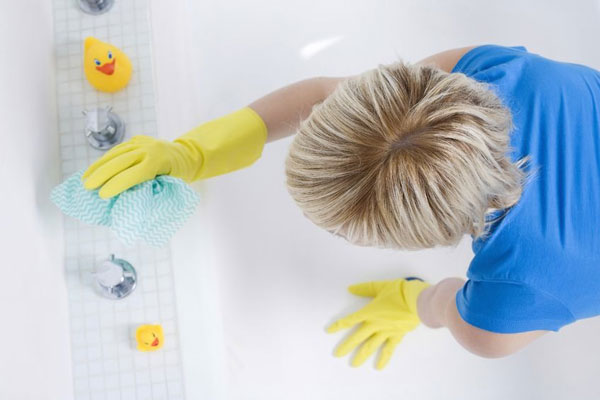Let’s get real: bathrooms and kitchens that look luxurious but are actually a nightmare to clean aren’t an option for today’s busy and practical women. Many of us don’t hire maids, and the thought of scrubbing grout before company comes over is mind-numbingly boring.
Fortunately, some kitchen and bathroom surfaces are far easier to clean and to maintain than others. If you’re in the market for a remodel, save yourself from grime-fueled angst and choose the kitchen and bathroom surfaces that are easiest to clean. This small but important detail can make the difference in how much you truly enjoy your remodeled space!
Easy-to-Clean Surfaces
- Linoleum or Vinyl. These seamless coverings are simple to wipe clean and easy for the DIYer to install. Linoleum or vinyl can go on floors, and vinyl wall coverings are also commonplace. They provide a smooth waterproof barrier while mimicking the timeless look of other surfaces like hardwood panels or tiles.
- Sealed Concrete. Polished, colored concrete creates a smooth, glassy surface that mimics the look of marble, tile or stone. The key to using concrete as an easy-to-clean surface in your home is to make sure it has a polished (not textured) finish and is sealed with a waterproofing agent. This material is easy to work with and therefore perfect for DIY projects, as long as you avoid certain faults when installing concrete.
- Stainless Steel. There’s a reason why stainless steel is the material of choice in professional kitchens and medical facilities: it is not only easy to clean, but also easy to disinfect. If you like a clean (albeit somewhat clinical) look or require surfaces that can be wiped clean of bacteria, food allergens, etc. in a snap, try stainless steel countertops.
- Marble or stone. True, the cost of marble puts it out of reach for many of us, but it can be a luxurious addition to a bathroom as a countertop. When an entire block of marble (or any other stone) is used to create a counter, there are no seams in which to trap water or dirt.
Avoid These Materials
Stay away from these materials unless you love to spend all your free time cleaning and scrubbing!
- Grout is exceptional at trapping dirt, and it requires far too much elbow grease to clean to make it worthwhile. If you just love the look of tile, however, there are a few workarounds: opt for a dark grout color, like slate gray, so that dirt won’t show, or use tile only in areas where it won’t need to be cleaned often, like as a border along the top of a wall.
- Unsealed or textured concrete. Concrete is naturally porous, meaning there are little holes throughout this seemingly solid surface where liquids and microscopic debris can become trapped. Concrete can become more mop-friendly with a sealer, but definitely stay away from textured concretes, including elaborate concrete stamps that create too many “hills and valleys.”
- This classic material is okay to use for cabinets and shelves in kitchens and bathrooms, but avoid hardwood floors and countertops. Wood requires a lot of maintenance when it receives a lot of traffic or is frequently exposed to water. The hassle of sanding and resealing wooden surfaces after water damage or after general use has worn down the sealant means it’s not worth using in these two busy (and mess-prone) areas of the house.
- Carpet is certainly a rare floor option to find in kitchens and bathrooms, but it does happen. If you love the plush feel of carpet under your feet, opt for area or throw rugs instead. These are easier to clean or to replace than carpet, which can hold moisture, dirt and bacteria for a very long time, even after professional cleaning.


